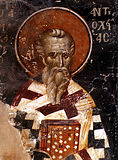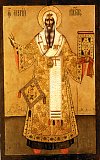

| Previous day | Next day |
| Old Style
February 12
|
Friday |
New Style
February 25
|
|
Tone 2.
Fast Day. |
Fish, wine and oil allowed.
|
![]() Appearance of the Iveron Icon of the Most Holy Theotokos (Mt. Athos) (9th c.).
Appearance of the Iveron Icon of the Most Holy Theotokos (Mt. Athos) (9th c.). ![]() St. Meletius, archbishop of Antioch (381).
St. Meletius, archbishop of Antioch (381). ![]() St. Alexis, metropolitan of Moscow (1378). St. Meletius, archbishop of Kharkov (1840).
St. Alexis, metropolitan of Moscow (1378). St. Meletius, archbishop of Kharkov (1840).
St. Mary, nun (who was called Marinus), and her father, St. Eugene, monk, of Alexandria (6th c.) St. Anthony II, patriarch of Constantinople (895). St. Meletius of Lardos, founder of Ypseni Monastery (late 19th c.). St. Bassian, founder of Ryabovsk Monastery (Uglich) (1509). Hieromartyr Urbanus, pope of Rome (223-230).
New Hiero-confessor Basil (Bogdashevsky), archbishop of Kanev (1933).
St. Ethilwald of Lindisfarne (740). St. Prochorus of Georgia, builder of Holy Cross Monastery near Jerusalem (1066). New Monk-martyrs Luke (Mukhaidze) (1277) and Nicholas (Dvali) (1314), of Jerusalem, and the holy fathers of the Georgian monasteries in Jerusalem. New Martyr Christos the Gardener, of Albania, at Constantinople (1748).
Repose of the cave-dweller Anastasia (Logacheva) of Ardatov (1875).
Thoughts for Each Day of the Year
According to the Daily Church Readings from the Word of God
By St. Theophan the Recluse

Friday. [II John 1:1–13; Mark 15:22–25, 33–41]
Saint John the Theologian writes, many deceivers are entered into the world, who confess not that Jesus Christ is come in the flesh (II John 1:7). Such it was in his time, whereas now deceivers enter the world, who confess that Christ is come in the flesh, but who nevertheless are “deceivers and antichrists” (cf. II John 1:7). This more openly began in the time of Arias and continues to this day. However, the ancient deceivers stumbled more in the dogma about the person of Jesus Christ our Saviour, whereas from the time of Luther they began to stumble in the teaching about salvation in Him. How many such “teachers” have there been? Such “deceivers and antichrists” have appeared among us, who say “believe and it is enough;” nothing more is needed—neither the Church, nor the Sacraments, nor the priesthood. These too begin their deception starting with Christ the Lord and salvation in Him. But since they do not interpret these correctly, they are antichrists, and subject to condemnation. Beware of them. Whosoever transgresseth, and abideth not in the doctrine of Christ hath not God (II John 1:9). These people do not have Him, because they do not have the doctrine of Christ. This doctrine is in the Church, and they have separated themselves from the Church. Only those who follow the Church have the doctrine of Christ and abide in it. They therefore have both Christ, the Son of God, and God the Father. But the others do not, although they keep saying that they do. Do not receive them, neither bid them God-speed (cf. II John 1:10).
Articles
 Venerable Mary (who was called Marinus), and her father at AlexandriaSaint Mary and her father Eugene lived at the beginning of the sixth century in Bithynia (northwestern Asia Minor). |
 St. Anthony the Patriarch of ConstantinopleSaint Anthony, Patriarch of Constantinople, was a native of Asia, but lived in Constantinople from his youth. |
 St. Bassian of UglichSaint Bassian came to the Protection monastery when he was thirty-three years of age, and was soon tonsured by Saint Paisius. |








